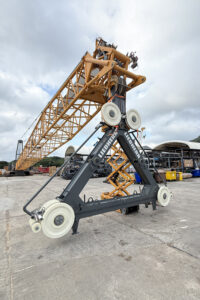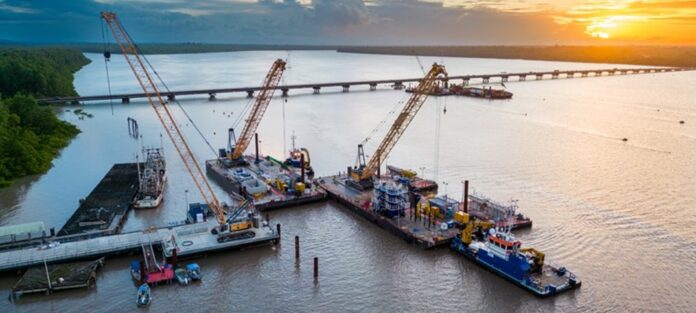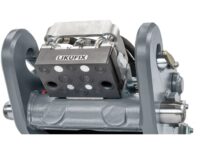Lifting work with crawler cranes can be very challenging – especially on floating structures with varying inclinations or when lifting very long loads.
For both applications, Liebherr-Werk Nenzing GmbH has developed customer solutions that make lifting safer and enable more efficient operations with just one crane, where previously a complex tandem lift was necessary. These features are available for crawler cranes in the LR series with lifting capacities between 130 and 400 tonnes.
Until now, tipping or turning long and heavy loads on jobsites usually required a tandem lift. With two crawler cranes in a very confined space and two teams that have to work well together, the level of coordination and additional costs are very high. For the tandem lift itself, lower lifting capacities apply for the cranes than for a lift with just one crane. With the pile-tilting device from Liebherr, such operations become a one-person routine. This replaces the standard rope pulley set on the boom and enables a single operator to tilt or rotate heavy components weighing up to 90 tonnes continuously from 0 degrees (horizontal) to 90 degrees (vertical) using the usual crane controls – with no diagonal pull on the boom.

Two hoisting winches act on separate hooks, which can be controlled synchronously or separately. The coupled speed of the two winches reduces the swaying of the load. As the pile-tilting device is mounted on exactly the same axis as the pulley set, this ensures that the geometry of the crane and the load measurement are not affected. This means that the load moment limitation always remains active and ensures a safe lifting process without compromising the load capacity.
Lifting operation with the pile-tilting device increases safety since the number of people in the danger zone is reduced. Furthermore, it is much more sustainable in terms of diesel consumption, emissions and transport costs. The advantage of only needing space for one crane instead of two is particularly evident in densely built-up urban areas. The pile-tilting device can be attached to all compatible crawler cranes in the LR series with lifting capacities from 130 to 400 tonnes, including those from older generations.
Floating unit operation
When lifting on floating structures, the operating personnel are faced with several challenges: When the crane swings and the load is lifted or set down, the change in the centre of gravity and the total weight (crane plus load) results in a change in the inclination of the barge or pontoon (list). This results in diagonal pull, which can lead to uncontrolled swaying of the load and to an overloading of the crane. When setting down the load with a small radius, the maximum angle of the jib can be exceeded due to the crane’s centre of gravity shifting to the rear, resulting in the risk of the crane tipping over.
Usually, only load charts on paper are available for operation on a floating unit – without implementing a load moment limitation on the control system. However, safe operation based solely on paper load charts is extremely difficult, as different load moments of the crane result in different listing of the barge. This effect is amplified when the crane swings because the barge usually has different longitudinal and transverse listing angles for the same load moment.

To improve the safety of crane operations on floating structures and to simplify their operation, Liebherr has developed a special operating mode for this purpose. The operating mode contains load curves for different inclinations (0°, 1°, 2°, 3°) with corresponding protection via the load moment limitation. The inclination of the floating unit is monitored during the entire operation and displayed to the operating personnel. If the permissible limit value is exceeded, a warning is issued and the operating personnel can adjust the load curves according to the respective inclination. Additionally, it prevents the maximum boom angle from being exceeded when the load is set down.
The assistance system ‘vertical line finder’ is part of the new safety concept. This ensures that the crane’s boom head is automatically moved over the centre of gravity of the load to be lifted. This prevents the load swaying and possible contact with obstacles, as well as people. At the touch of a button, this system enables the crane driver to avoid diagonal pull – especially those caused by changes in the inclination of the floating unit as a result of the shift in the centre of gravity when lifting and setting down the load. The service life of the crane is also extended through lower dynamic forces on the boom.
Source: Liebherr






